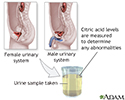Citric acid urine test
Urine - citric acid test
Citric acid urine test measures the level of citric acid in urine.
How the Test is Performed
You will need to collect your urine at home over 24 hours . Your health care provider will tell you how to do this. Follow instructions exactly so that the results are accurate.
Collect your urine at home over 24 hour
The urine 24-hour volume test measures the amount of urine produced in a day. The amount of creatinine, protein, and other chemicals released into t...

How to Prepare for the Test
No special preparation is necessary for this test. But the results are affected by your diet, and this test is usually done while you are on a normal diet. Ask your provider for more information.
How the Test will Feel
The test involves only normal urination, and there is no discomfort.
Why the Test is Performed
The test is used to diagnose renal tubular acidosis and evaluate kidney stone disease.
Renal tubular acidosis
Proximal renal tubular acidosis is a disease that occurs when the kidneys don't properly remove acids from the blood into the urine. As a result, to...

Kidney
The term "renal" refers to the kidney. For example, renal failure means kidney failure. Related topics:Kidney diseaseKidney disease - dietKidney fai...

Normal Results
The normal range is 320 to 1,240 mg per 24 hours.
Normal value ranges may vary slightly among different laboratories. Some labs use different measurements or test different samples. Talk to your provider about the meaning of your specific test results.
What Abnormal Results Mean
A low level of citric acid may mean renal tubular acidosis and a tendency to form calcium kidney stones.
The following may decrease urine citric acid levels:
- Chronic kidney failure
-
Diabetes
Diabetes
Diabetes is a chronic disease in which the body cannot regulate the amount of sugar in the blood.
 ImageRead Article Now Book Mark Article
ImageRead Article Now Book Mark Article - Excessive muscle activity
- Medicines called angiotensin converting enzyme inhibitors (ACE inhibitors)
-
Parathyroid glands do not produce enough of its hormone (
hypoparathyroidism
)
Hypoparathyroidism
Hypoparathyroidism is a disorder in which the parathyroid glands in the neck do not produce enough parathyroid hormone (PTH).
 ImageRead Article Now Book Mark Article
ImageRead Article Now Book Mark Article -
Too much acid in the body fluids (
acidosis
)
Acidosis
Acidosis is a condition in which there is too much acid in the body fluids. It is the opposite of alkalosis (a condition in which there is too much ...
 ImageRead Article Now Book Mark Article
ImageRead Article Now Book Mark Article
The following may increase urine citric acid levels:
-
A high
carbohydrate
diet
Carbohydrate
Carbohydrates are one of the main nutrients in our diet. They help provide energy for our body. There are three main types of carbohydrates found i...
 ImageRead Article Now Book Mark Article
ImageRead Article Now Book Mark Article - Estrogen therapy
-
Vitamin D
Vitamin D
Vitamin D is a fat-soluble vitamin. Fat-soluble vitamins are stored in the body's fatty tissue.
 ImageRead Article Now Book Mark Article
ImageRead Article Now Book Mark Article
Risks
There are no risks with this test.
References
McPherson RA, Ben-Ezra J. Basic examination of urine. In: McPherson RA, Pincus MR, eds. Henry's Clinical Diagnosis and Management by Laboratory Methods . 22nd ed. Philadelphia, PA: Elsevier Saunders; 2011:chap 28.
Sreedharan R, Avner ED. Renal tubular acidosis. In: Kliegman RM, Stanton BF, St Geme JW III, Schor NF, eds. Nelson Textbook of Pediatrics . 20th ed. Philadelphia, PA: Elsevier; 2015:chap 529.
-
Citric acid urine test - illustration
The citric acid test measures citric acid in urine and is used to diagnose renal tubular acidosis and evaluate renal stone disease.
Citric acid urine test
illustration
-
Peptic ulcers
(In-Depth)
-
Obesity
(Alt. Medicine)
Review Date: 10/13/2015
Reviewed By: Walead Latif DO, Nephrologist, Medical Director of Fresenius Vascular Care, and Clinical Assistant Professor of Rutgers Medical School, Newark, NJ. Review provided by VeriMed Healthcare Network. Also reviewed by David Zieve, MD, MHA, Isla Ogilvie, PhD, and the A.D.A.M. Editorial team.

